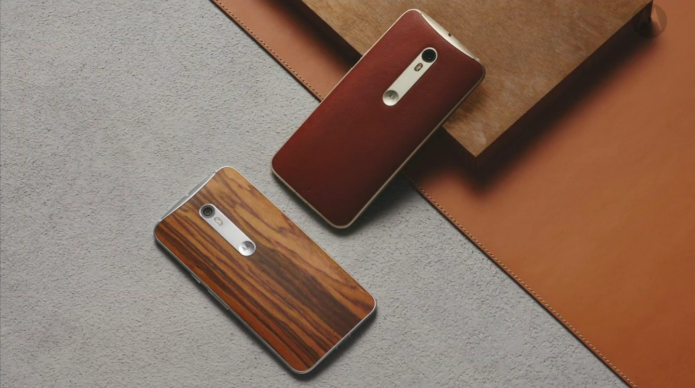GOOD STUFF
- Efficient design
- No bloatware
- Attractive price
BAD STUFF
- Camera focus is unreliable
- Materials aren’t as premium as competition
THE BREAKDOWN
More times than not, the Verge score is based on the average of the subscores below. However, since this is a non-weighted average, we reserve the right to tweak the overall score if we feel it doesn’t reflect our overall assessment and price of the product.
- DESIGN : 8
- DISPLAY : 8
- CAMERA(S) : 8
- RECEPTION / CALL QUALITY : 8
- PERFORMANCE : 8
- SOFTWARE : 9
- BATTERY LIFE : 8
- ECOSYSTEM : 9
The ideal Android smartphone looks like this: it has good design, fast performance, clean software, and it doesn’t cost as much as an iPhone. Motorola’s been chasing that ideal since 2013 with its Moto X phones, which have always had an attractive ergonomic design, an unencumbered Android experience, and pricing well below flagship smartphones from Apple and Samsung. But at the same time, the Moto X has also represented what many consider to be the worst of Android: lousy cameras and mediocre battery life.

Now Motorola is launching its third edition of the Moto X, which you can preorder starting today. The Moto X Pure Edition (or Moto X Style if you’re not in the US) is a lot like its predecessors. It’s also aggressively priced, perhaps more so than ever before, starting at just $399 completely unlocked. That last bit is important as the new Moto X isn’t being sold through carriers (in the US, at least) at all — you can only purchase it direct from Motorola or from its retail partners (Best Buy and Amazon). But it’s compatible with all four major US carriers, which is still a rarity among unlocked phones.
Beyond working with virtually any SIM card you might have, Motorola says this year’s phone includes a class-leading camera, addressing the biggest complaint with its prior devices. Based on Motorola’s promises, you’d think that it’s finally cracked how to build the perfect Android smartphone. I’ve been using it for the past week, and, well, it’s far from perfect. It’s not the best smartphone you can buy, Android or otherwise. But it is a really good smartphone at a really great price, and to do better than the new Moto X, you’re going to have dig much deeper into your wallet.
/cdn0.vox-cdn.com/uploads/chorus_asset/file/4023996/moto-x-pure-edition-6918.0.jpg)
Motorola’s been using the same design theme across its products since the first Moto X, and the new version doesn’t deviate from it at all. That’s fine; the curved shape and tapered sides of the phone make it comfortable to hold, and though it’s not as thin as other smartphones, it doesn’t feel like a chunky brick. It’s a good-looking design that works.
/cdn0.vox-cdn.com/uploads/chorus_asset/file/4024028/moto-x-pure-edition-6938.0.jpg)
/cdn0.vox-cdn.com/uploads/chorus_asset/file/4024042/moto-x-pure-edition-6949.0.jpg)
In fact, the new Moto X looks so similar to last year’s version that you might be hard-pressed to tell them apart at first glance. It has the same dual front-facing speakers, same metal trim, and same customizable back, where you can choose from various woods, leathers, or plastic finishes using Moto Maker. (Our review unit has a handsome walnut finish.)
There are two distinct differences: the camera surround on the back has been redesigned (though it feels like it was changed just for the sake of changing something, and not for any particular purpose), and the phone is much bigger this time, housing a significantly larger 5.7-inch display. That display pushes the Moto X from a small- to medium-sized device into Big Phone territory, and make no mistake, this a Big Phone. But like theGalaxy Note 5, the Moto X doesn’t feel as big as it looks, and it’s not completely unwieldy to use. (The Nexus 6 has only a slightly larger display, but feels significantly bigger than the Moto X, for example.) It also fits in my pocket, and I didn’t drop it a single time in the week I’ve been using it. We all want phones with big screens, but at the same time want them to be manageable to use. This year, Motorola and Samsung (and to a certain extent, LG) have seemed to figure out the formula to make that work.

The similarities to Samsung’s flagship phone largely end there, however. The Moto X is a well-built device with a smart and efficient design, but it’s not nearly as premium feeling as Samsung’s device. The phone has all the pieces of a flagship phone: metal rim, Gorilla Glass front, and nice styling. But there’s a subtle sense that the pieces don’t all mesh into a singular whole like they could. For example, the curves from the front to the metal sides are plastic. None of this makes it look cheap, but it doesn’t take long to figure out which is the more expensive device when you compare it to a Galaxy Note 5.
Motorola’s new, 5.7-inch quad HD LCD display also isn’t nearly as nice as Samsung’s panels. It’s not a bad screen by any means. Motorola went with an LCD display this time around, and it’s sharp, colorful, usable outdoors, and has good viewing angles. But it’s not eye-popping or class leading by any stretch. It’s a functional display that does its job, but it doesn’t encourage you to stare at it and appreciate its beauty.
/cdn0.vox-cdn.com/uploads/chorus_asset/file/4024006/moto-x-pure-edition-6962.0.jpg)
Perhaps the biggest (and most anticipated) upgrade from last year to this is the Moto X’s new 21-megapixel camera. It’s a significant leap in both resolution and capability over the 13-megapixel model from last year, and it does a much better job at taking photos. But last year’s model set a really low bar, and while the new camera is much better, it’s still outclassed by Apple, LG, and Samsung’s cameras.
Images taken in good lighting conditions are bright and colorful, though there’s a tendency for them to look over-sharpened. It makes the images look unnaturally digital and not as attractive as those captured by the Note 5, iPhone 6 Plus, or G4. In poor lighting, the Moto X does a much better job than before, but it still misses focus often and pictures come out much softer than I’d expect. I also wish it had optical image stabilization, which has basically become a must for any premier smartphone.


If this sounds like I’m being overly critical of the camera, that’s because I am. The camera is one of the most important features on any smartphone, and it’s something that many people use every single day. It’s one of the few things that can make or ruin a smartphone experience, as my colleague Vlad Savov has pointed out time and again. The Moto X’s camera isn’t bad by any means, it’s just not as good as other options.
On the plus side, the Moto X’s camera is better than virtually any other option in its price range, including the OnePlus 2 or ZTE Axon Pro. Its app is also quick, and the twist gesture to launch the camera is faster and more reliable than before. (It’s still not as quick as Samsung’s double tap on the home button, however.) But if you’re looking for the absolute best smartphone camera, the Moto X doesn’t have it.
The front-facing camera on the Moto X is a 5-megapixel unit with a wide angle lens, which is great for selfies. Motorola decided to put an LED flash on the front this year, but I don’t recommend using it. It put spots in my eyes and produced unnatural lighting. It’s no shocker that a bright light shined two feet away from your face is exactly as terrible as it sounds.
/cdn0.vox-cdn.com/uploads/chorus_asset/file/4024002/moto-x-pure-edition-6930.0.jpg)
The Moto X is equipped with Qualcomm’s Snapdragon 808 and 3GB of RAM, which is a good combination for solid, reliable performance. The X didn’t exhibit significant stuttering or lag while I used it, and it handled games without issue. It also didn’t get uncomfortably warm, even when multitasking or playing games. The 808 is not a top of the line processor, however, and the X never felt as snappy quick or lightning fast as other Android phones that have come out this year.
Battery life has been a concern with the Moto X in the past, and fortunately, the new model doesn’t have trouble lasting an entire day for me. Given the size of the X and its 3,000mAh battery, I would have loved to have gotten two days out of it, but it’s still an improvement and par for the course at this point. The Moto X lacks the wireless charging features that the Note 5 or Nexus 6 have, but it does come with a quick charger that can rapidly top up the battery when you need it to. In my tests, the battery went from completely exhausted to 100 percent charged in just about an hour, which is quite impressive.
/cdn0.vox-cdn.com/uploads/chorus_asset/file/4024018/moto-x-pure-edition-7055.0.jpg)
Motorola’s approach to software is largely unchanged, and that’s a good thing. The X runs Android 5.1 Lollipop that’s about as close to stock as you can get outside of the Nexus range. There are no annoying interface changes or duplicated apps, and since the Moto X comes completely unlocked, there are no carrier apps or bloatware to worry about. The few things that are included are useful: I really like the Moto Display feature that wakes the screen up with new notifications or when I pull the phone out of my pocket, and the Assist feature is great when I want my phone automatically silenced during a meeting. Motorola talks a lot about the always-available voice control on the X line, but I’ve found I don’t use that particular feature all that often, and most Android phones have something like that now anyway.
The Moto X Pure Edition sits at the top of Motorola’s lineup, but it’s actually a really good mid-range phone with an attractive, but appropriate, mid-range price. It doesn’t really match or compete with higher-priced flagship devices like the iPhone 6 Plus or Galaxy Note 5. It also lacks things like a fingerprint scanner or wireless charging, which are becoming more commonplace on high-end smartphones this year.
But to do better than the Moto X, you have to spend a lot more money, and it’s not clear to me that the investment is worth it for most people. The Moto X has a better design, better performance, and better camera than any other smartphone available for under $500. Unless you’re prepared to spend hundreds of dollars more, you’re not going to find something better. Its few faults aren’t really things that ruin its experience, and the Moto X proves that you don’t need to be class-leading in order to make a really great phone.
As it turns out, in 2015, a really good mid-range smartphone is also a really good overallsmartphone, and the Moto X Pure Edition is the best mid-range smartphone you can get.
(theverge.com)



